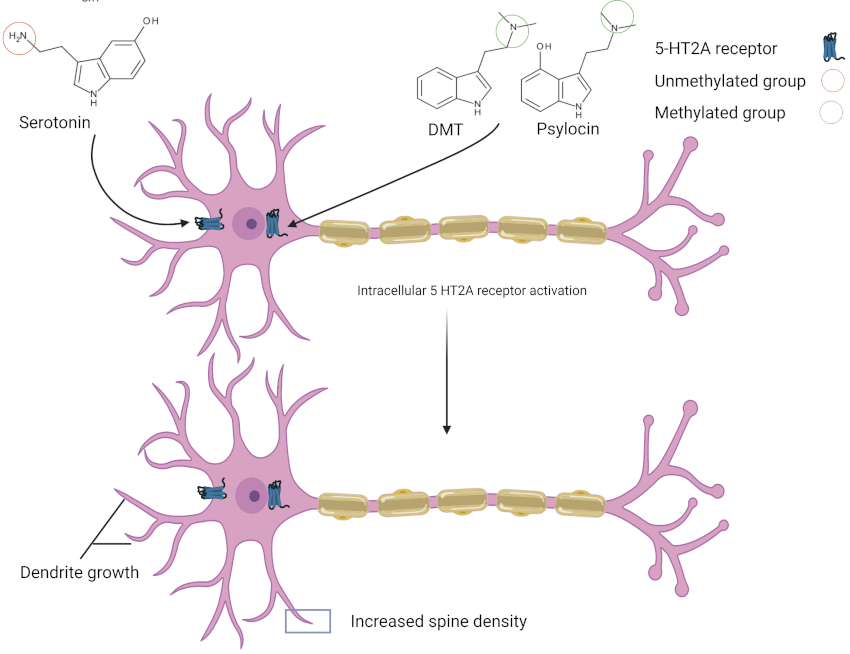‘Key achievement’ in psychedelics research boosts search for new neurological drugs

A new study into the mechanism of action behind psychedelics has been hailed as an “important step forward” in the quest to design better neurological treatments.
Research by the University of California, Davis (UCD), shows that engaging 5-HT2A receptors (5-HT2ARs) inside neurons promotes the growth of new connections, whereas engaging the same receptors on neural surfaces does not.
As well as identifying this ‘location bias’ in 5-HT2AR ligands, the UCD team was able to demonstrate that methylated psychedelics such as DMT (the main psychoactive component of ayahuasca), and psilocin (a psychedelic mushroom alkaloid produced from psilocybin) exhibited increased membrane permeability and enabled the activation of intracellular 5-HT2ARs.
The sustained increases in dendrite growth and spine density prompted by the psychedelic compounds suggests that intracellular receptors could be viable therapeutic targets for treating depression, PTSD, and other neurological disorders in future. Analysing the UCD report in Science, University of Maryland scientists Evan M. Hess and Todd D. Gould called it “a key achievement in the understanding of the mechanism of action of psychedelics,” adding: “these findings are an important step forward for a rapidly expanding and much-needed field of study.”
UCD is one of several leading research institutions currently exploring the potential of psychedelics as tomorrow’s psychotherapy drugs – either in their classical form, or as engineered novel compounds that treat neurological disorders without an accompanying ‘trip’. This revival of interest in psychedelics comes in response to both the continued prevalence of depression worldwideand the limited efficacy and side effects associated with selective serotonin reuptake inhibitor drugs (SSRIs). As Hess and Gould note, these problems have “led to a shift in the search for depression therapeutics in favor of rapid-acting compounds… which can result in sustained therapeutic effects for days or longer after a single dose.”
Hess and Gould also point to significant unknowns regarding the use of psychedelics to treat neurological orders – most significantly “gaps in our understanding of the neurobiological mechanisms that are engaged by psychedelic compounds”, as well as concerns about their therapeutic potential at scale and adverse side-effects. They conclude that the UCD study represents “a potentially therapeutically relevant mechanism of action for DMT and psilocin… that involves 5-HT2AR”, but also caution that “much needs to be done” to establish the safety and effectiveness of signalling through intracellular 5-HT2ARs.

Serotonin readily activates membrane bound 5-HT2A receptors, but its unmethylated amino group (red circle) restricts membrane permeability of this neurotransmitter. In contrast, membrane permeability of classic psychedelic compounds DMT and psilocin is increased by methylation of their amino groups (green circles). These compounds can permeate neurons and activate intracellular 5HT2A receptors, promoting subsequent increases in dendrite growth and spine density.
Figure adapted from: Hess et al., Possible psychedelic therapeutic mechanisms: Science 2023 Feb 17;379(6633):642-643
“This will require interrogation of the specific signaling cascades engaged by intracellular 5-HT2ARs that lead to increased dendritic growth and spine density and defining the mechanistic relationship of such changes to cognitive processes,” they argue.
“Moreover, understanding whether the findings for DMT are fully shared with all psychedelics (such as the structurally dissimilar mescaline), which was only partially explored… will be needed before the proposed mechanism can be described as a common psychedelic mechanism.”
In their research paper, the UCD team states that the impressive therapeutic effects of psychedelics may be related to their ability to promote cortical neuron growth and repair the decreased dendritic spine density that isa “hallmark” of many depression-related diseases. Noting like Hess and Gould that the “the mechanisms by which receptor activation leads to changes in neuronal growth are still poorly defined”, the group set out to examine why some serotonin 2A receptors promoted growth – or ‘plasticity’– and others did not.
Given that location bias has been postulated as an explanation for signalling differences between membrane-permeable and membrane-impermeable ligands in opioid drug research, the group focused on the role of intracellular 5-HT2AR receptors within the Golgi body in the response to psychedelics.
After treating cultured rat nerve cells with serotonin, tryptamine, 5-methoxytryptamine (5-MeO–TRY), and N-methyl and their corresponding N,N-dimethyl congeners including DMT and psilocin, they observed that increasing N-methylation led to an enhanced ability to promote neuronal growth. Thus, while highly polar compounds like serotonin could not easily cross the lipid membranes that surround cells, more lipophilic psychedelics were not only able to enter the neuron but also “exhibited greater abilities to promote structural plasticity than polar compounds.”
“Here, we extend the concept of location bias to ligands of the 5-HT2AR,” the UCD report concludes.
“Our results demonstrate that membrane permeability is essential for a ligand to activate 5-HT2ARs in cortical neurons.”
Speaking after the release of the report, senior author and UCD group leader David E. Olson predicted that the new findings would help guide further research into new drugs for depression, PTSD and other disorders.
"It gives us deeper mechanistic insight into how the receptor promotes plasticity, and allows us to design better drugs," he said.
TRC research chemicals for mental disorders and neurodegenerative diseases
TRC has more than 40 years’ experience working through some of the most complex synthetic pathways to deliver you high quality research chemicals. We have a large range, including many unique bioactive molecules for research into mental disorders and neurodegenerative diseases, and our world-leading chemists are expert in engineering specific solutions for customers. TRC also provides wide ranging controlled substances, hallucinogens, and psychedelics. To support neurobiology in general, ATCC offer a large collection of in vitro tools, including NPC derived from normal and Parkinson’s donors, LRRK2 KI lines, Schwann cells, >70 brain lines and HCMI Patient Derived brain cancer models.
|
